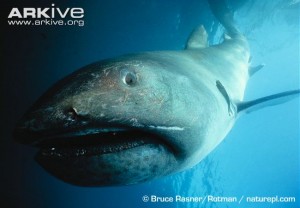High Connectivity and Low Diversity in Megamouth Sharks
The megamouth is one of the rarest sharks in the world. Surprisingly for an animal that can reach 7 meters in length, it was described only in 1983, and only ~100 specimens have been found. This is largely because it is a deep-water species, spending days at 200 meters or more, but rising close to the surface to feed at night. This odd-looking animal is one of only three living species of filter-feeding shark, along with the whale and basking sharks. Megamouth sharks have been found in all major oceans, and are assumed to have a global range, but the largest number of animals comes from the waters of the Philippines, Taiwan and Japan. The warm Kuroshio Current sweeps north from the Philippines, along the eastern coast of Taiwan, and up to Japan. Half of all known megamouth sharks have been found along the Taiwanese coast. Beyond these clues to its distribution, however, nothing is known about megamouth shark migration or population structure. A new study by Liu et al used genetic analysis to examine the global structure of megamouth populations – the relatedness of animals found in different parts of the world. The authors collected tissue samples from megamouth sharks caught in drift and gillnet fisheries as bycatch, the inadvertent catch of one species while targeting another. Between 2013 and 2015, 27 megamouth sharks were caught off the eastern Taiwan coast. Liu et al also obtained two tissue samples from megamouth sharks caught off Baja California, Mexico, and made use of two other available DNA sequences, from Puerto Rico and Indonesia.
The authors analyzed a mitochondrial gene, Cytochrome oxidase I, and a nuclear microsatellite called Loc6. The authors found three mitochondrial haplotypes (different versions of the COI gene), with most animals sharing a single haplotype across Taiwan, Mexico, Puerto Rico and Indonesia. At the microsatellite Loc6, sharks from Taiwan and Mexico carried identical sequences. This data indicates that there is remarkably little genetic variation within the megamouth sharks examined. If this is true for the rest of the population, megamouth sharks are one of the least genetically diverse of all shark species. This is of practical concern, as genetic diversity buffers a population against biological threats, such as disease, and against environmental ones, such as climate change. Species with low genetic diversity are at greater risk of extinction during times of population stress. The fact that megamouth sharks from Taiwan and Mexico carried the same haplotype also suggests that there is little population division within megamouths, and that animals are likely highly migratory.
The authors propose that the Kuroshio Current may serve as a sort of megamouth “highway”, and between April and August these sharks pass Taiwan on a migration between breeding and feeding grounds. The megamouth shark is currently considered a species of Least Concern by the IUCN, due to its very large range. The current study however shows that given the high capture rate for the species (27 sharks over 3 years at one location), and their low genetic diversity, this listing may need to be revised to reflect a more at-risk status. The data for megamouth sharks is not dissimilar from what has been found for another large filter feeding shark, the whale shark. Whale sharks show no population structure across the vast Indo-Pacific, evidence that these animals can also migrate long distances. While the megamouth study could analyze only two genetic markers in a small number of samples, it represents an essential first genetic analysis of the species. Further study of more animals is necessary to reinforce and extend these findings.
The open-access article is:
Liu SYV, Joung SJ, Yu C-J, Hsu H-H, Tsai W-P, Liu KM. (2018) Genetic diversity and connectivity of the megamouth shark (Megachasma pelagios). PeerJ 6:e4432. DOI:10.7717/peerj.4432

